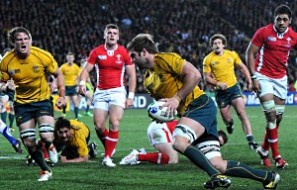Gusman
new author
Roar Rookie

There has been much angst about the influence that penalty goals have in determining rugby results. A nail-biting penalty goal attempt to win the game at the death is compelling, but penalty goals shouldn’t dictate the game.
The essence of rugby has always been about running with the ball, and scoring tries is what everyone wants to see, not endless shots at goal.
It just seems too easy.
One solution to this problem would be to consider splitting penalties into those that are allowed to kick for goal and those that aren’t. The experimental law variations (ELV) tried to tackle this but in hindsight perhaps they did not get it quite right.
The problem with the ELVs was that while teams got a free kick for a short arm penalty, they did not get the throw-in to the next lineout. As possession is so important in rugby, teams felt the best option was to tap and run, rather than kick away the ball. Perhaps a simple review of that rule could provide an answer.
The idea is that the previous ELV short-arm penalty offences (hands in the ruck, taking down a scrum, not releasing the ball, etc.) would give teams the same options as a full-arm penalty with the exception of taking a shot at goal. This would encourage teams to kick to touch and gain an attacking lineout close to the opposition line.
By gaining the lineout throw, the team awarded the penalty will improve their field position by 30-40 metres. If the game was stopped around the middle of the field, chances are they will be well inside the opposition 22 with the lineout throw, which gives them a great attacking opportunity.
It keeps the game moving, allows the attacking team to continue their momentum, while putting the defending team under even more scrutiny.
Many teams are happy to give away a penalty as three points is better than seven, plus there is a 50/50 chance that the kicker will miss the penalty attempt. It also gives the defending team a couple of minutes of break to catch their breath, or reorganise their defence.
With this rule change they would be back in their own 22 with no break and the added pressure of defending close to their line.
Crowds love it when teams kick to the corners on penalties, and it would create more confrontations close to the try line, instead of duelling penalty shots from 50 metres. Surely more tries would follow.
Some may argue teams will deliberately offend, knowing they won’t risk giving away thee points. I think most teams would not be happy to give the opposition the ball and go backwards 30 metres. The referee has yellow cards if required or could upgrade it to a full penalty. There is also the white card now, so with good refereeing that would not be an issue.
Currently many games are being decided on a 50/50 scrum penalty that could have gone either way, and the kicker knocks over three points to win the game. By removing penalty shots from smaller offences, results will come back more towards who scored the tries rather than who kicked more goals, which I think is more in the spirit of the game as it was invented.
I will always enjoy watching when a kicker lines up a shot at goal on the bell with the game in the balance. I’d just prefer if he scored a try in the corner first.